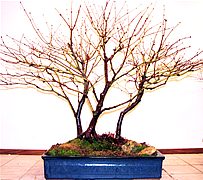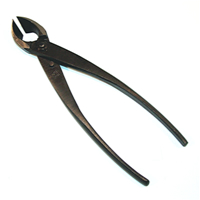 Definition of Bonsai
Definition of Bonsai
Bonsai, pronounced bone-sigh, can be defined as the union between art and nature. The word bonsai can literally be defined by breaking the word into its two components, bon, meaning tray and sai, meaning tree. Bonsai, tree or shrub planted in a tray, is an art form that essentially has no end. The tree is alive and continually changing.
What can be made into Bonsai?
Although any tree or shrub can be planted into a pot and trained into bonsai, in order to maintain the miniature look of bonsai, trees with naturally small features are typically used as bonsai material. Some common varieties include Japanese Maples, Chinese Elms, Junipers, and Serissa, to name a few. Some plants are used for their special features, such as Wisteria for it’s long purple or white blooming ability, or Crabapple for it’s blooming and fruiting ability.
Some basic tree categories:
Tropical/Subtropical
Tropical and Subtropical bonsai trees are commonly grown indoors all year round. Some bonsai types include Ficus, Serissa, Fukien Tea, Brush Cherry, Bougainvillea, Dwarf Umbrella, and some Elms. There are many different varieties within each family of bonsai. For example, Serissa includes Japanese Pink Serissa, Snow Rose Serissa, and Chinese Serissa, to name a few. Many tropical/subtropical bonsai are easily maintained as indoor bonsai all year round as long as watering and lighting needs are maintained.

Deciduous
Deciduous bonsai trees annually shed their leaves in winter as they enter their winter dormancy period. Deciduous bonsai include Maple, Larch, Crabapple, Apricot, Hornbeam, Gingo, and many Elm species, to name a few. Deciduous bonsai are not suitable for growing indoors during the winter months because they require their winter rest period, which is facilitated by the colder weather. Deciduous bonsai are known for their Spring and Fall foliage color changes. Colors typically range from yellow to oranges to deep reds.
Evergreen
Evergreen bonsai trees maintain their foliage throughout the season changes. Evergreen bonsai types include Junipers, Boxwoods, most Pines, and Azalea, to name a few. Some evergreen bonsai exhibit a dull green or yellowish tint to their foliage during their winter dormancy period. Most evergreen bonsai require a winter dormancy period, or rest period, in order to maintain their ongoing health.
Some Basic Tools
There are many different types of tools that are used to create bonsai but we have created many bonsai with three basic typed of tools. The three basic tools are basic scissors, concave cutters, and a chopstick.
Basic Scissors
Scissors are used to cut the foliage, smaller branches, and roots. There are many specialized types of scissors. No matter what your scissor of choice may be, it is important to maintain a sharp edge on all of your tools in order to cleanly cut through branches and not smash them. Cutting branches cleanly helps to promote healing and reduces the chances of disease. Scissors used to cut branches should be kept separate from those used to cut roots. Scissors used to cut roots dull much more quickly than those used to cut branches. In keeping two separate sets of scissors you will ensure that your scissors used to prune foliage and small branches are kept sharp.
 Concave Cutters
Concave Cutters
Concave cutters are used to cut larger branches. Concave cutters cut a small indentation into the truck or branch in order to facilitate healing. As with all bonsai cutting tools, a sharp edge should be maintained in order to cleanly cut through branches and not smash them. Clean cuts help to promote healing and reduce the chances of disease on the freshly cut surface. We consider concave cutters the second most important tool used to prune and train bonsai.
Chopstick
We use a basic bamboo chopstick for many purposes including working new soil into the freshly planted bonsai and separating roots from old soil. By gently working the chopstick back and forth (not poking) during the potting process, new soil can be introduced into the old root ball. Gently working the new soil into the old root ball helps to introduce new soil into existing soil and reduces any air pockets within the soil. In a similar fashion, the chopstick can be used to separate roots within the root ball. By gently working the chopstick back and forth within the root ball, roots can be gently separated from the root ball, where they can be easily trimmed or removed.
Deprecated: strpos(): Passing null to parameter #1 ($haystack) of type string is deprecated in /home/agriviek8Qv/agriviet.net/public_html/wp-includes/comment-template.php on line 2522